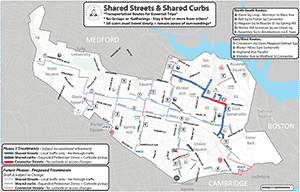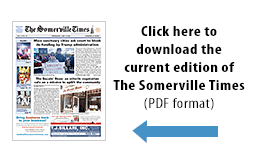Additional measures planned to aid contactless pickup and social distancing. The Somerville Shared Streets plan prioritizes creating routes that connect residents to critical services.
In late May, the City of Somerville will begin a Shared Streets pilot program in an effort to provide more walking and biking routes that allow for social distancing. Routes will connect residents to essential services like food distribution sites, medical facilities, and grocery stores. The Shared Streets initiative opens up low-volume or residential side-streets to pedestrians, cyclists, and other users while still allowing vehicle access for residents of the street, first responders, delivery drivers, sanitation trucks, and street sweepers.
The first Shared Streets route, which will be up in running in early June, will connect Winter Hill and East Somerville neighborhoods and include the Somerville Public Schools food distribution sites at the Healey and East Somerville Community schools; the Project Soup Food Pantry at 165 Broadway; Stop and Shop; and the Capuano School. Subsequent routes will open throughout the summer, which will give city Mobility staff members time to evaluate each route and make changes as needed. To see a full map of planned routes and schedule, visit our SomerVoice site at https://somervoice.somervillema.gov/covid19mobility. As routes are implemented, feedback on them can also be submitted on SomerVoice.
“As we begin to reopen the economy and more people need to leave their homes, we need to make sure we have safe options for that. This is essential planning for life during a pandemic,” said Mayor Joseph A. Curtatone. “We’re anticipating more people will be on foot or on bikes in these warm weather months, and we’re creating more space for safe, accessible transportation. Our community has shown tremendous resolve and made many shared sacrifices during the COVID-19 emergency, and now is not the time to let our guard down. Somerville’s shared streets are for moving, not for gathering. We’ll be relying on everyone to use the streets responsibly and remember that we are all in this together.”
Safety measures include signage and flexible barriers to alert all users to the shared use of these streets. Somerville’s program will use temporary materials that can be modified based on our experience and feedback from residents with the pilot. Motorists allowed to use a shared street, such as abutters, should drive slowly and expect to see people in the street on these routes. People walking, rolling, and biking should remain alert and aware and make room for these allowed vehicles.
Sidewalk expansions, Curbside Pickup Areas, and Touchless Walk Signals
Along with the Shared Streets pilot, the city will be implementing several measures starting this month intended to improve public safety and social distancing on Somerville streets, including temporary sidewalk expansions in commercial areas, pickup/drop-off measures in business districts, and the introduction of touchless walk signals.
The city will be temporarily widening sidewalks in central business districts to provide more room for customers to social distance while waiting for pickup from stores and restaurants. Traffic cones and other movable barriers placed in the street a few feet from the curb will be used to create additional space for circulation and queuing. The city has also modified parking meters in many business districts to allow 15-minute pickup/drop-off activities that support local businesses.
“As economic activity returns to Somerville’s commercial squares, we must keep workers, customers, and passersby safe from community transmission of COVID-19,” said Mayor Curtatone. “Temporary sidewalk expansions and 15-minute vehicle parking will help facilitate contactless curbside retail and restaurant take-out business. These strategies have been successfully deployed in dozens of cities around the world over the past two months, and I look forward to Somerville’s first pilot projects.”
Somerville has also begun a pilot to modify city-controlled traffic signals where the equipment allows this. This will eliminate the need for pedestrians to push a button to gain a walk signal. The measure reduces unnecessary physical contact with the push button, reducing the likelihood of viral transmission from a high-touch surface. Multilingual informational signage is being installed at each modified signal. The Mobility Team is also working in partnership with the MA Department of Transportation to make similar changes to State-owned walk signals, while exploring equipment upgrades for city signals that currently cannot be changed to touchless.
Finally, a broader exploration of public realm solutions is underway to support the community and local businesses as we seek to move toward greater activity safely. The city’s Planning, Public Space, Public Schools, and Parks and Recreations staff are reviewing best practices worldwide during the pandemic for moving more activities and business outdoors. More to come.
For more information and regular COVID-19 updates, visit www.somervillema.gov/coronavirus and sign up for city alerts at www.somervillema.gov/Alerts. We urge you to sign up for every alert method you are able to receive: phone call, text, email. Also follow FB.com/SomervilleCity and @SomervilleCity.
















Who are these mobility experts deciding these things? The Jacques Street one makes no sense as we have one way streets to and from so to make it impossible for just people who live on the street. The roads are horrid for bikes. Why not do a simple resurfacing on the area where bikes go. I know we would really like the streets there repaired as they should be but that should not cost much. It’s horrible for little cars which is why many of us in that area have gone back to big suv’s.
“Somerville has also begun a pilot to modify city-controlled traffic signals where the equipment allows this.”
In order for this to be suggested, researched and completed successfully, a traffic engineer would be needed. Do we have one? Full time? Part time?
I thought that the Director of Traffic and Parking was ‘required’ to be an engineer. In recent years, though, I believe this requirement has gone by the wayside.
Brad Rawson would be the person in charge. The city council has no power over him so he pretty much has free reign. We have 4 mobility experts but I have no clue how they showed up. When the city shared the plan on social media, some people responded asking if there had been a public input process, but Rawson responded saying the one thing he has known Somerville to be united on is the need for traffic calming citywide. So this is why we do not have a say. Which means the people, the taxpayers are without input. I have tried to find out how to get the city council to have say over Brad but it is a long difficult process. Brad only answer to the mayor from what I can find out. So they are free to dictate to us what they want to do. We have no vote, no say. Nothing.